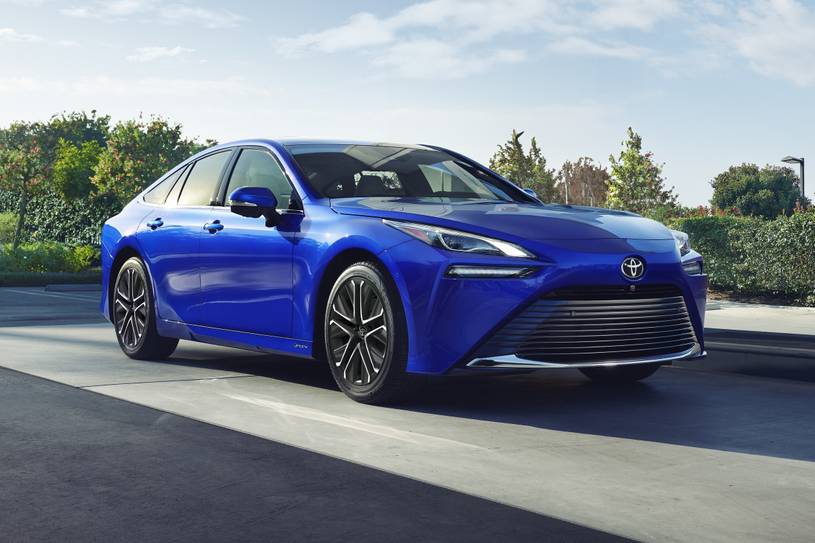Choosing the Right Electric, Hybrid, Plug-In, or Fuel-Cell Vehicle
You’ve likely seen ads or been told about “electrified” vehicles and how simple it would be to convert to one of them, so what does that actually mean? The most common example is electric cars, but the definition is broader. Any car that has an electric motor as a part of its drivetrain fits into this category. That covers Hybrid, Plug-In Hybrid, battery-Electric Vehicle, and even those hydrogen Fuel-Cell vehicles.
Each of these brings certain pros and cons, and what works for one person may not work as well for another. So how do you determine which type — hybrid, plug-in hybrid, electric vehicle or fuel-cell car — is right for you? Let’s unpack it and explore your options.
Battery-Electric Vehicles
Battery-electric cars have a straightforward concept: The battery that powers them is located beneath the floor and has to be recharged. It would be ideal if such charging could happen overnight at home, when electricity prices may be at their lowest. Tesla sold around half of the EVs in the United States today and constructed the very dependable, frictionless, and widespread Supercharger fast-charging network. You can drive a Tesla almost anyplace in the lower 48 states because to that network.(Electric Hybrid Plug-In Hy rid Fuel-Cell)
Almost every other automaker has introduced or plans to introduce a range of electric vehicle models, the majority of which are SUVs in the many sizes and combinations that now dominate the U.S. auto market.
Advantage:
Compared to cars with internal combustion engines (ICE), electric vehicles (EVs) are quieter, more peaceful, and more comfortable to drive. Since electric motors generate their greatest power at 0 rpm, they have tremendous acceleration from a stop. After all, who doesn’t like winning a stoplight drag race? Since EVs have a lot fewer moving components, maintenance mostly consists of changing the cabin air filters, wiper blades, and tires. Additionally, they are far less expensive per mile than any gasoline-powered vehicle if you can charge them overnight at home or throughout the day at work.In order to power a radio or a cooler while parked, certain EVs may export electricity through 120-volt electrical outlets. Some even provide your home with backup power during blackouts, however there are a few restrictions. Also, keep in mind that no tailpipe equals no emissions.
Disadvantage:
Although the price disparity between EVs and equivalent ICE cars is closing and could disappear in a few years, EVs are presently more expensive to purchase. Public charging infrastructure might be unexpected if you are unable to charge where you live or work. Too many of the third-party charging networks that non-Tesla EVs rely on are unreliable and poorly maintained. Although it’s still a work in progress, the expectation that EV charging will be at least as simple and enjoyable as your neighborhood gas station shouldn’t be that high. Owners of longer road journeys must make extra preparations because not all EVs currently have Tesla’s smooth navigation and charging integration. Additionally, EVs lose more range than gasoline-powered cars while traveling at high speeds or in extremely low temperatures.
Hybrids
Hybrid-electric vehicles, of which the Toyota Prius is the most well-known kind, have been on the market for more than 20 years. They use one or two electric motors to augment the power produced by its gasoline engine. An electric motor uses energy that would otherwise be squandered to replenish the battery when the engine overruns or there is mild braking. Hybrids may operate on electricity alone for brief periods of time while traveling at moderate speeds or with light loads.
Under the hood of a hybrid, a lot is happening. This is because of control algorithms that require power from a combination of the motors and the engine and vary the power supply from the battery to the electric motors. Because modern hybrids are so much quieter than their predecessors, owners might not be able to tell whether their engine is turning on or off. Most manufacturers will produce more hybrid cars as national pollution regulations tighten; nevertheless, you might not be able to tell they are hybrids other than by a little emblem.
Advantage:
Because the driver doesn’t need to alter their behavior, hybrids are the most user-friendly kind of electric vehicle. They are fueled similarly to conventional gasoline-powered vehicles, albeit less frequently. (They also change brake pads less frequently because the electric motor does a lot of the braking.) Those who frequently travel long distances on unknown routes, park on the street or in an apartment, or just don’t want to learn how to plug in a car are the greatest candidates for hybrids.
Disadvantage:
Although the price gap between hybrids and nonhybrids is narrowing, hybrids are still more expensive to purchase. Although owners become accustomed to it, it might be unsettling for drivers to hear engine noise fluctuating without a corresponding change in road speed. Hybrids may be perceived by some as geeky or as a means of expressing political views. You continue to blast carbon dioxide (CO2) into our common air and consume fuel, of course.
Plug-In Hybrids
Among electric vehicles, plug-in hybrids (PHEVs) could be the least known. In certain situations, it is an EV, while in others, it is a traditional gasoline-electric hybrid. It can travel 20 to 50 miles on electricity alone because to its battery pack. The majority of the driving for owners who can plug in overnight is done using grid energy; the engine could not start for days.
The automobile smoothly transitions to a standard hybrid-electric vehicle once its electric range is reached. Additionally, the gasoline engine is there to remove range worry for unforeseen travel, lengthy road trips, or situations in which you are unable to plug in.
Advantage:
Plug-in hybrids are adored by owners who know what they are, and they’re as affordable per mile as electric vehicles (EVs) unless you regularly drive more than 40 miles a day, which isn’t the case for 80% of cars in the US. Installing a specialized EV charging station is not necessary because the majority may be recharged overnight using a typical 120-volt wall socket. Additionally, because their electric motors are more powerful, they are frequently more powerful than non-plug-in hybrids when they switch to gas-electric hybrids. Certain PHEVs are eligible for state or federal purchasing incentives that are not available to conventional hybrids.
Disadvantage:
It may be somewhat challenging to explain PHEVs: “It’s a hybrid? Yes, but it’s also an electric vehicle. Oh, how far does it travel? Just thirty miles? However, why would I desire that? They may not be available in every state, and they cost more than similar plug-free hybrid versions. Dealers may not even mention the plug to buyers, much alone explain the subtleties of plugging in. Additionally, they are just more costly and heavier hybrids if owners do not plug them in.
Hydrogen Fuel-Cell Vehicles
FCEVs, or hydrogen fuel-cell vehicles (HFCVs), like the Toyota Mirai seen above, do not require a plug to charge. Instead, they run only on hydrogen, which is injected into a fuel cell that turns it into electricity by combining it with air. This electricity then drives one or another electric motor. Water vapor is the only exhaust they produce. The hydrogen is kept in highly reinforced tanks integrated into the car’s frame at extremely high pressures (10,000 psi).
Only California sells hydrogen versions, which are a relatively small subgroup of electric cars. The expense and reliability issues of building a consumer hydrogen fuelling network from the ground up cast doubt on their future in the United States.
Advantage:
HFCVs are torquey, quiet, and smooth, much like any other vehicle driven by an electric motor. They don’t require a plug, and the process is similar to filling up at a gas station: locate a hydrogen fuel pump, insert the hose’s nozzle into the car’s receptacle, and wait for the fuelling to be finished, which usually takes three to five minutes at most.
Disadvantage:
The future of hydrogen-powered passenger cars in North America is uncertain. For massive Class 8 commercial tractor-trailer rigs, a large portion of the development work has turned to hydrogen. There are currently no road excursions from Los Angeles to Dallas because California is the only state where hydrogen vehicles may be fueled. The fuel is quite costly at open-market prices, and the aircraft-quality nozzles are hefty and can be difficult to lock into position. The three manufacturers that have sold hydrogen-powered cars—Hyundai, Toyota, and Honda—all give free fuel for a set amount of time or up to a specific mileage. Additionally, the automobile is essentially a two-ton doorstop when nearby gas stations close: no electricity, no gasoline, and no drive.

Conclusion: Your needs and lifestyle will determine which automobile is best for you: BEVs are perfect if you want little maintenance and home charging. With hybrids, you may save gasoline without having to make major changes to your regular routine. PHEVs provide flexibility for both short and long travels, whereas HFCVs are innovative but have infrastructure problems. Analyze your driving habits and preferences to find the best fit.
Related Post : BMW i3 : Where Sustainability Meets Innovation in Electric Mobility


